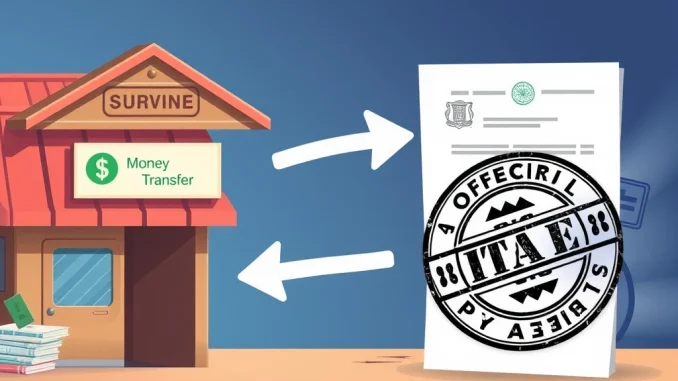
Imagine sending money to family abroad. Now, imagine a new tax making that process more expensive and potentially less private. That’s the scenario potentially unfolding with a proposed US remittance tax, and it has significant implications, particularly for crypto adoption.
A proposal from the U.S. House of Representatives suggests a 5% tax on remittances. While seemingly aimed at traditional money transfer services, analysts like Crypto in America host Eleanor Terrett point out a critical detail: the potential exemption of peer-to-peer (P2P) transactions and self-custody tools. This loophole could inadvertently drive users away from traditional finance and toward decentralized cryptocurrency options.
Understanding the Proposed US Remittance Tax
The core idea behind the proposed legislation is to tax money sent out of the United States. Remittances, the funds sent by individuals to recipients in other countries, are a massive global industry, providing vital support for families in many nations. Traditionally, these transfers happen through banks or dedicated money transfer companies like Western Union or MoneyGram.
These traditional services operate within regulated frameworks. They require users to provide identification, comply with Know Your Customer (KYC) and Anti-Money Laundering (AML) regulations, and their transactions are trackable and reportable to authorities. A 5% tax layered on top of existing fees could make these services significantly more expensive for the millions of people who rely on them.
The stated goals for such a tax could range from generating government revenue to potentially discouraging illicit financial flows. However, the unintended consequences, particularly concerning privacy and technological shifts, are drawing considerable attention.
How the Tax Might Boost Crypto Adoption
This is where the cryptocurrency angle becomes prominent. The potential exclusion or difficulty in applying the tax to peer-to-peer crypto transactions and those using self-custody wallets creates a stark contrast with traditional methods.
Consider these points:
- Decentralization: Unlike traditional services with central intermediaries, cryptocurrency networks like Bitcoin or Ethereum allow users to send value directly to each other (P2P). There’s no central company to easily levy a tax upon or compel reporting from.
- Self-Custody: When users hold their own private keys in a non-custodial wallet, they control their funds directly. There’s no third party holding the assets that can be easily targeted by taxation or reporting requirements related to specific transactions like remittances.
- Transaction Nature: A crypto transaction is simply a transfer on a public ledger. Identifying its specific *purpose* as a ‘remittance’ and taxing it at the point of origin becomes technically challenging, especially without a regulated intermediary involved.
If traditional remittance costs increase due to the tax, and the process involves more stringent surveillance, users seeking cheaper, faster, or more private alternatives may naturally look towards cryptocurrency. This economic incentive, coupled with the technical difficulty of taxing decentralized transfers, could accelerate crypto adoption among remittance users.
Addressing the Rising Privacy Concerns
While increased crypto adoption might be a consequence, the underlying mechanism driving it – the imposition of taxes and potentially stricter surveillance on traditional finance – raises significant privacy concerns.
Critics argue that taxing and monitoring remittances could lead to increased government overreach into personal financial lives. Traditional remittance users might face:
- More detailed questioning about the purpose of transfers.
- Increased reporting thresholds being lowered.
- Greater surveillance of financial activity linked to international transfers.
This heightened scrutiny on traditional channels makes the privacy offered by peer-to-peer crypto and self-custody solutions more appealing. However, it also highlights a tension between government desires for oversight and individual financial freedom.
The debate centers on whether the government’s need to track money flows (for reasons like preventing crime or ensuring tax compliance) justifies potentially compromising the financial privacy of everyday citizens sending money to family.
Traditional vs. Crypto Remittances Under the Proposed Tax
Let’s look at a simplified comparison:
| Feature | Traditional Remittance (Under Proposed Tax) | Crypto Remittance (P2P/Self-Custody) |
|---|---|---|
| Cost | Existing fees + Potential 5% tax | Network fees (often lower) + Exchange fees (if applicable) |
| Speed | Hours to days | Minutes to hours (depending on network) |
| Intermediary | Required (Bank, Money Transfer Co.) | None (P2P) |
| Taxation Point | Easy to identify and tax intermediary/transaction | Difficult to identify ‘remittance’ purpose; no central point to tax P2P |
| Privacy/Surveillance | High (KYC/AML, reporting, potential increased scrutiny) | Higher (pseudonymous on ledger, no central reporting entity for P2P) |
| Ease of Use | Generally high for non-technical users | Requires some technical understanding of crypto |
| Volatility Risk | Low (fiat currency) | Can be high (depends on crypto asset used) |
This table illustrates why, despite potential technical hurdles and volatility, the cost and privacy advantages of crypto could become more compelling if the US remittance tax is implemented.
Potential Challenges and Considerations
While the tax plan might push users towards crypto, it’s not without challenges:
- User Education: Many remittance users, particularly older demographics or those in regions with less tech access, may not be familiar with crypto, peer-to-peer crypto transfers, or how to use self-custody wallets safely.
- Volatility: Using volatile cryptocurrencies like Bitcoin or Ethereum for remittances carries price risk between sending and receiving. Stablecoins could mitigate this, but they introduce other considerations.
- Recipient Access: The recipient must also have the ability to receive and use crypto, which might require access to exchanges or a local crypto economy.
- Regulatory Response: Governments could eventually attempt to regulate the ‘off-ramps’ (converting crypto back to local currency) or exchanges more strictly to counteract the shift.
Despite these hurdles, the economic pressure from a remittance tax could provide a strong incentive for users to overcome them, further fueling crypto adoption.
What Does This Mean for You?
If you currently send remittances or are concerned about financial privacy, this proposed tax highlights the evolving landscape:
- Stay informed about the legislative process and how the bill progresses.
- Research traditional remittance service fees if the tax is implemented.
- Explore how cryptocurrencies, particularly stablecoins and P2P methods, function for international transfers.
- Understand the difference between custodial and self-custody wallets and the privacy implications of each.
The potential for a US remittance tax to inadvertently boost crypto adoption underscores the powerful role incentives and regulations play in shaping financial behavior. It also brings the debate around financial surveillance and privacy concerns to the forefront.
Conclusion: A Pivotal Moment for Remittances and Crypto?
The proposed US remittance tax represents a fascinating case study in how traditional regulatory approaches can collide with decentralized technology. While intended perhaps for revenue or control, the exemption of peer-to-peer crypto and self-custody tools could make cryptocurrency a significantly more attractive option for remittance users globally.
This shift, however, comes hand-in-hand with heightened privacy concerns surrounding traditional finance channels. As governments grapple with how to regulate a rapidly changing financial world, the outcome of proposals like this will likely play a key role in accelerating or hindering the mainstream adoption of cryptocurrency for practical, everyday uses like sending money across borders.



